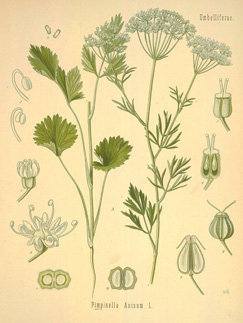Alluring Anise
By Audrey Stallsmith

Woe unto you, scribes and Pharisees, hypocrites! for ye pay tithe of mint and anise and cumin, and have omitted the weightier matters of the law, judgment, mercy, and faith. . .
Matthew 23:22
Anise is one of those herbs that seldom gets employed anymore except during the holidays, since it is an ingredient in many ethnic cookies, such as the Central European springerles. I haven’t tried making them, since I never experience much success with any kind of baked goods that require rolling out. You don’t want to see my attempts at pie dough!
Unfortunately, I don’t think I’ve ever tried growing anise either. I could have been scared off by the--possibly erroneous--idea that it only produces seed in hot climates. Also, I usually start my plants in advance indoors, and anise is one of those with a long taproot that reportedly doesn’t transplant well.
Growing to about 2 feet with ferny leaves and umbels of tiny white or yellow flowers, Pimpinella anisum reportedly flowers in mid-summer and produces its 1/5-inch ribbed seeds in autumn. Pimpinella derives from dipinella, meaning “twice pinnate” in reference to the feathery upper leaves.
The annual herb has also been known as aniseed or sweet cumin. Place it near coriander for a more vigorous plant, as the two species reportedly like each other enough to be healthier together than apart. You may gather anise leaves for salads and teas, though it is the seeds which are most often harvested. They can be added to potpourris and sachets as well as to supper.
I’ll have to make a note to myself to try the herb, since it is one of the oldest out there, having been grown in ancient Egypt and even—as the scriptural quote proves—mentioned in the Bible. Some scholars think the writers actually meant dill in this particular context, but those scribes and Pharisees could have been growing anise too.
The ancient Romans used it to spice dessert cakes called mustaceum, which were probably meant to improve their digestion of all that had gone down before. It has also been used to flavor a wide variety of other edibles, including liquors such as aniseed and absinthe.
Actually, many candies—such as black jellybeans and the like--that were supposed to be licorice-flavored were actually spiced with anise. It has recently been supplanted itself, however, by the less expensive star anise (Illicium verum).
That’s a shame, since anise has so much to offer. It could also come in handy this time of year as a pleasant treatment for colds, bronchitis, and asthma. The herb contains alpha-pinene, which helps expel excess phlegm. Of course, as James Duke points out in The Green Pharmacy, fennel offers over twenty times more of that medicinal ingredient than anise does. If you don’t have any fennel on hand, however, you can always give anise a try instead. It will at least sweeten your breath and improve your digestion. It was also frequently used to doctor up the taste of less palatable medicines.
After all, an herb that is so attractive to animals must have something going for it. Often employed to lay a trail for foxhounds when there were no foxes available, it has also been used to attract fish and trap mice. And that’s not all it can lure in.
Anise is considered an aphrodisiac too, and I seem to recall a study that found one of the scents considered most sexy by both men and women was licorice-flavored candies. Of course, pumpkin pie and lavender were popular too, so I'm guessing that somebody who combined anise, cinnamon, and lavender in perfumes or aftershaves could make a fortune.
In the meantime, you can just allure your family to the table with some anise-scented cookies. I’m sure, if I put my mind to it, I can find some that don’t require a rolling pin!
Pimpinella anisum image is from Kohler's Medizinal-Pflanzen, courtesy of the Missouri Botanical Garden.








